Pseudolites to Support Location Services in Smart Cities: Review and Prospects
Abstract
1. Introduction
2. Brief Development History and Existing Applications
2.1. For Aircraft Positioning
2.2. For Train Positioning
2.3. For Underwater Positioning
2.4. For Deformation Monitoring
2.5. For Deep Space Positioning
2.6. Cases of Practical Application
2.6.1. The Locata System
2.6.2. The Beidou/GPS Dual-Mode System
2.7. An Underlying Positioning Technology for the Internet of Things
3. Architecture and Technical Issues on the System Side
3.1. Signal Intensity and Near–Far Effect
3.2. Clock Synchronization
3.3. Orbital and Ranging Problems
3.4. Constellation Optimization
4. Algorithmic and Technical Issues on the User Side
4.1. Multipath
4.2. Resilient Processing Models
4.2.1. The Function Model in Positioning
4.2.2. The Stochastic Model in Positioning
4.2.3. Next Steps
4.3. Integrated Positioning with Other Methods
5. Pseudolites as a Spatial Reference: Discussion and Prospects
6. Pseudolite-Based Location Service: Conceived Application in Smart Cities
6.1. Intelligent Transportation
6.2. Smart Health and Lifestyle
6.3. Public Safety and Emergency Response
7. Conclusions
Author Contributions
Funding
Data Availability Statement
Conflicts of Interest
References
- Minetto, A.; Dovis, F.; Vesco, A.; Garcia-Fernandez, M.; López-Cruces, À.; Trigo, J.L.; Molina, M.; Pérez-Conesa, A.; Gáñez-Fernández, J.; Seco-Granados, G. A testbed for GNSS-based positioning and navigation technologies in smart cities: The HANSEL project. Smart Cities 2020, 3, 1219–1241. [Google Scholar] [CrossRef]
- van Den Bossche, A.; Dalcé, R.; Val, T. LocURa4IoT—A Testbed Dedicated to Accurate Localization of Wireless Nodes in the IoT. IEEE Sens. J. 2021, 22, 5437–5446. [Google Scholar] [CrossRef]
- Yang, B.; Guo, L.; Guo, R.; Zhao, M.; Zhao, T. A novel trilateration algorithm for RSSI-based indoor localization. IEEE Sens. J. 2020, 20, 8164–8172. [Google Scholar] [CrossRef]
- Wang, W.; Zhu, Q.; Wang, Z.; Zhao, X.; Yang, Y. Research on Indoor Positioning Algorithm Based on SAGA-BP Neural Network. IEEE Sens. J. 2021, 22, 3736–3744. [Google Scholar] [CrossRef]
- Blewitt, G.; Boucher, C.; Davies, P.; Heflin, M.; Herring, T.; Kouba, J. ITRF Densification and Continuous Realization by the IGS. In Advances in Positioning and Reference Frames; Springer: Berlin/Heidelberg, Germany, 1998; pp. 8–17. [Google Scholar]
- El-Sheimy, N.; Li, Y. Indoor navigation: State of the art and future trends. Satell. Navig. 2021, 2, 7. [Google Scholar] [CrossRef]
- Sonnessa, A.; Saponaro, M.; Alfio, V.S.; Capolupo, A.; Turso, A.; Tarantino, E. Indoor Positioning Methods—A Short Review and First Tests Using a Robotic Platform for Tunnel Monitoring. In Proceedings of the International Conference on Computational Science and Its Applications, Cagliari, Italy, 1–4 July 2020; pp. 664–679. [Google Scholar]
- Yang, Y.; Mao, Y.; Sun, B. Basic performance and future developments of BeiDou global navigation satellite system. Satellite Navigation 2020, 1, 1. [Google Scholar] [CrossRef]
- Zuo, Z.-Y.; Qiao, X.; Wu, Y.-B. Concepts of comprehensive PNT and related key technologies. In Proceedings of the International Conference on Modeling, Analysis, Simulation Technologies and Applications, Hangzhou, China, 26–27 May 2019. [Google Scholar]
- Kim, C.; So, H.; Lee, T.; Kee, C. A pseudolite-based positioning system for legacy GNSS receivers. Sensors 2014, 14, 6104–6123. [Google Scholar] [CrossRef]
- Wang, J. Pseudolite applications in positioning and navigation: Pro-gress and problems. J. Glob. Position. Syst. 2002, 1, 8–56. [Google Scholar] [CrossRef]
- Harrington, R.; Dolloff, J. The inverted range: GPS user test facility. In Proceedings of the IEEE PLANS’76, San Diego, CA, USA, 1–2 November 1976; pp. 204–211. [Google Scholar]
- Cobb, H.S.; Cohen, C.E.; Parkinson, B.W. Theory and design of pseudolites. In Proceedings of the 1994 National Technical Meeting of The Institute of Navigation, San Diego, CA, USA, 24–26 January 1994; pp. 69–75. [Google Scholar]
- Cobb, H.S. GPS Pseudolites: Theory, Design, and Applications; Stanford University: Stanford, CA, USA, 1997. [Google Scholar]
- Beser, J.; Parkinson, B.W. The application of NAVSTAR differential GPS in the civilian community. Navig. J. Inst. Navig. 1982, 29, 107–136. [Google Scholar] [CrossRef]
- Kalafus, R.M.; Van Dierendonck, A.; Pealer, N.A. Special Committee 104 recommendations for differential GPS service. In Proceedings of the 42nd Annual Meeting of the Institute of Navigation, Seattle, DC, USA, 24–26 June 1986; pp. 45–54. [Google Scholar]
- Wolf, R.; Thalhammer, M.; Hein, G.W. GATE-The german galileo test environment. In Proceedings of the 16th International Technical Meeting of the Satellite Division of The Institute of Navigation (ION GPS/GNSS 2003), Portland, OR, USA, 9–12 September 2003; pp. 1009–1015. [Google Scholar]
- Kuusniemi, H.; Bhuiyan, M.Z.H.; Ström, M.; Söderholm, S.; Jokitalo, T.; Chen, L.; Chen, R. Utilizing pulsed pseudolites and high-sensitivity GNSS for ubiquitous outdoor/indoor satellite navigation. In Proceedings of the 2012 International Conference on Indoor Positioning and Indoor Navigation (IPIN), Sydney, NSW, Australia, 13–15 November 2012; pp. 1–7. [Google Scholar]
- Chen, R.; Hyttinen, A.; Chen, Y.; Strom, M.; Laitinen, H.; Tossaint, M.; Martin, S. Development of the EGNOS pseudolite system. J. Glob. Position. Syst. 2007, 6, 119–125. [Google Scholar] [CrossRef][Green Version]
- Montefusco, C.; Traveset, J.; Rodriguez, R.; Toran, F.; Jofre, M. Enhancing SBAS Performance: The EGNOS pseudolite concept. In Proceedings of the European Navigation Conference, Munich, Germany, 19–22 July 2005. [Google Scholar]
- Kang, G.; Tan, L.; Hua, B.; Zheng, F. Study on p seudolite system for BeiDou based on dynamic and independent aircrafts configuration. In Proceedings of the China Satellite Navigation Conference (CSNC) 2013 Proceedings, Wuhan, China, 15–17 May 2013; pp. 159–172. [Google Scholar]
- Chao, M.; Jinling, W.; Jianyun, C. Beidou compatible indoor positioning system architecture design and research on geometry of pseudolite. In Proceedings of the 2016 Fourth International Conference on Ubiquitous Positioning, Indoor Navigation and Location Based Services (UPINLBS), Shanghai, China, 2–4 November 2016; pp. 176–181. [Google Scholar]
- Gan, X.; Yu, B.; Chao, L.; Liu, S. The development, test and application of new technology on Beidou/GPS dual-mode pseudolites. In Proceedings of the China Satellite Navigation Conference (CSNC) 2015 Proceedings, Xi’an, China, 13–15 May 2015; Volume I, pp. 353–364. [Google Scholar]
- Hein, G.W.; Eissfeller, B.; Werner, W.; Ott, B.; Elrod, B.D.; Barltrop, K.; Stafford, J. Practical investigations on DGPS for aircraft precision approaches augmented by pseudolite carrier phase tracking. In Proceedings of the 10th International Technical Meeting of the Satellite Division of The Institute of Navigation (ION GPS 1997), Kansas City, MO, USA, 16–19 September 1997; pp. 1851–1860. [Google Scholar]
- Cohen, C.E. Real-time cycle ambiguity resolution using a pseudolite for precision landing of aircraft with GPS. In Proceedings of the 2nd DSNS, Amsterdam, The Netherlands, 30 March–2 April 1991. [Google Scholar]
- Elrod, B.; Barltrop, K.; Van Dierendonck, A. Testing of GPS augmented with pseudolites for precision approach applications. In Proceedings of the 7th International Technical Meeting of the Satellite Division of The Institute of Navigation (ION GPS 1994), Salt Lake City, UT, USA, 20–23 September 1994; pp. 1269–1278. [Google Scholar]
- Van Dierendonck, A.; Fenton, P.; Hegarty, C. Proposed airport pseudolite signal specification for GPS precision approach local area augmentation systems. In Proceedings of the 10th International Technical Meeting of the Satellite Division of the Institute of Navigation (ION GPS 1997), Kansas City, MO, USA, 16–19 September 1997; pp. 1603–1612. [Google Scholar]
- Ko, P.-Y. GPS-Based Precision Approach and Landing Navigation: Emphasis on Inertial and Pseudolite Augmentation and Differential Ionosphere Effect. Master’s Thesis, Stanford University, Stanford, CA, USA, 2000. [Google Scholar]
- Lee, H.-K.; Soon, B.; Barnes, J.; Wang, J.; Rizos, C. Experimental analysis of GPS/Pseudolite/INS integration for aircraft precision approach and landing. J. Navig. 2008, 61, 257–270. [Google Scholar] [CrossRef]
- Pervan, B.S.; Cohen, C.E.; Parkinson, B.W. Integrity monitoring for precision approach using kinematic GPS and a ground-based pseudolite. J. Inst. Navig. 1994, 41, 159–174. [Google Scholar] [CrossRef]
- Galijan, R.C.; Lucha, G.V. A suggested approach for augmenting GNSS category III approaches and landings: The GPS/Glonass and Glonass pseudolite system. In Proceedings of the 6th International Technical Meeting of the Satellite Division of The Institute of Navigation (ION GPS 1993), Salt Lake City, UT, USA, 22–24 September 1993; pp. 157–160. [Google Scholar]
- Yun, H.; Han, D.; Kim, C.; Kim, O.-J.; Song, J.; No, H.; Kim, J.; Kim, D.; Kee, C. Development of Pseudolite Based Augmentation System (PBAS). In Proceedings of the ION 2015 Pacific PNT Meeting, Honolulu, HI, USA, 20–23 April 2015; pp. 1055–1058. [Google Scholar]
- Yun, H.; Han, D.; Kee, C. Preliminary Test Results of Pseudolite-Based Augmentation System (PBAS). In Proceedings of the ION 2013 Pacific PNT Meeting, Honolulu, HI, USA, 23–25 April 2013; pp. 631–635. [Google Scholar]
- Amt, J.H.; Raquet, J.F. Flight testing of a pseudolite navigation system on a UAV. In Proceedings of the 2007 National Technical Meeting of the Institute of Navigation, San Diego, CA, USA, 22–24 January 2007; pp. 1147–1154. [Google Scholar]
- Lee, H.K.; Wang, J.; Rizos, C.; Barnes, J. Analysis of pseudolite augmentation for GPS airborne applications. In Proceedings of the 15th International Technical Meeting of the Satellite Division of The Institute of Navigation (ION GPS 2002), Portland, OR, USA, 24–27 September 2002; pp. 2610–2618. [Google Scholar]
- Wang, J.J. Integration of GPS, INS and Pseudolite to Geo-Reference Surveying and Mapping Systems. Ph.D. Thesis, UNSW Sydney, Sydney, NSW, Australia, 2007. [Google Scholar]
- Skrypnik, O.; Kargapol’cev, S.; Sizykh, V.; Daneev, A.; Aref’ev, R. Characteristics of the integrated GLONASS accuracy field in the optimal placement of pseudo satellites in the aerodrome zone. Appl. Anal. Discret. Math. 2018, 19, 83–91. [Google Scholar] [CrossRef]
- Lo, S.; Chen, Y.; Enge, P.; Pelgrum, W.; Soelter, A. Flight test of a pseudo-ranging signal compatible with existing distance measuring equipment (DME) ground stations. Navigation 2020, 67, 567–582. [Google Scholar] [CrossRef]
- Ma, C.; Yang, J.; Chen, J.; Tang, Y. Time synchronization requirement of global navigation satellite system augmentation system based on pseudolite. Meas. Control 2019, 52, 303–313. [Google Scholar] [CrossRef]
- Ma, W.; Yuan, J.; Luo, J. Airborne pseudolite aiding BeiDou system to improve positioning precision in low latitude areas. In Proceedings of the International Conference on Space Information Technology, Wuhan, China, 19–20 November 2005. [Google Scholar] [CrossRef]
- Zhao, X.; Liu, J.; Cai, B.; Lu, D.; Wang, J. Research on Optimized Pseudolite Constellation Design under Constrained GNSS Environment in Railway Stations. In Proceedings of the 2019 IEEE Intelligent Transportation Systems Conference—ITSC, Auckland, New Zealand, 27–30 October 2019. [Google Scholar]
- Liu, J.; Zhao, X.-L.; Cai, B.-G.; Wang, J. Pseudolite Constellation Optimization for Seamless Train Positioning in GNSS-Challenged Railway Stations. IEEE Trans. Intell. Transp. Syst. 2021, 23, 13636–13654. [Google Scholar] [CrossRef]
- Progri, I.F.; Michalson, W.R. An underground system of stationary pseudolites. J. Geolocation Geo-Inf. Geo-Intell. 2020, 2020, 38–47. [Google Scholar] [CrossRef]
- Youngberg, J.W. A novel method for extending GPS to underwater applications. Navigation 1991, 38, 263–271. [Google Scholar] [CrossRef]
- Tiwary, K.; Sharada, G.; Singh, A. Underwater Navigation using Pseudolite. Def. Sci. J. 2011, 61, 331–336. [Google Scholar] [CrossRef][Green Version]
- Yang, Y.; Xu, T.; Xue, S. Progresses and prospects of marine geodetic datum and marine navigation in China. J. Geod. Geoinf. Sci. 2019, 1, 16–24. [Google Scholar]
- Yang, Y.; Qin, X. Resilient observation models for seafloor geodetic positioning. J. Geod. 2021, 95, 79. [Google Scholar] [CrossRef]
- Grosch, A.; Enneking, C.; Greda, L.A.; Tanajewski, D.; Grunwald, G.; Ciećko, A. Theoretical Concept for a Mobile Underwater Radio-Navigation System Using Pseudolite Buoys. Remote Sens. 2020, 12, 3636. [Google Scholar] [CrossRef]
- Qi, K.; Qu, G.; Xue, S.; Xu, T.; Su, X.; Liu, Y.; Wan, J. Analytical optimization on GNSS buoy array for underwater positioning. Acta Oceanol. Sin. 2019, 38, 137–143. [Google Scholar] [CrossRef]
- Dai, K.; Li, Z.; Xu, Q.; Bürgmann, R.; Milledge, D.G.; Tomas, R.; Fan, X.; Zhao, C.; Liu, X.; Peng, J. Entering the era of earth observation-based landslide warning systems: A novel and exciting framework. IEEE Geosci. Remote Sens. Mag. 2020, 8, 136–153. [Google Scholar] [CrossRef]
- Benoit, L.; Briole, P.; Martin, O.; Thom, C.; Malet, J.-P.; Ulrich, P. Monitoring landslide displacements with the Geocube wireless network of low-cost GPS. Eng. Geol. 2015, 195, 111–121. [Google Scholar] [CrossRef]
- Shen, N.; Chen, L.; Wang, L.; Hu, H.; Lu, X.; Qian, C.; Liu, J.; Jin, S.; Chen, R. Short-term landslide displacement detection based on GNSS real-time kinematic positioning. IEEE Trans. Instrum. Meas. 2021, 70, 1004714. [Google Scholar] [CrossRef]
- He, Y.; Xu, G.; Kaufmann, H.; Wang, J.; Ma, H.; Liu, T. Integration of InSAR and LiDAR Technologies for a Detailed Urban Subsidence and Hazard Assessment in Shenzhen, China. Remote Sens. 2021, 13, 2366. [Google Scholar] [CrossRef]
- Hu, B.; Chen, J.; Zhang, X. Monitoring the land subsidence area in a coastal urban area with InSAR and GNSS. Sensors 2019, 19, 3181. [Google Scholar] [CrossRef]
- Liu, C.; Gao, J.; Zhao, X.; Zhang, A.; Yu, X. Simulation and experiment analysis of dynamic deformation monitoring with the integrated GPS/pseudolite system. J. Geophys. Eng. 2014, 12, 45–56. [Google Scholar] [CrossRef]
- Meng, X.; Roberts, G.; Dodson, A.; Cosser, E.; Barnes, J.; Rizos, C. Impact of GPS satellite and pseudolite geometry on structural deformation monitoring: Analytical and empirical studies. J. Geod. 2004, 77, 809–822. [Google Scholar] [CrossRef]
- Scaioni, M.; Marsella, M.; Crosetto, M.; Tornatore, V.; Wang, J. Geodetic and remote-sensing sensors for dam deformation monitoring. Sensors 2018, 18, 3682. [Google Scholar] [CrossRef] [PubMed]
- Guoliang, S.; Lifang, W.; Rui, F.; Weihua, C. GNSS for Lunar Surface Positioning Based on Pseudo-satellites. In Proceedings of the 2019 IEEE 8th Joint International Information Technology and Artificial Intelligence Conference (ITAIC), Chongqing, China, 24–26 May 2019; pp. 1348–1353. [Google Scholar]
- LeMaster, E.A.; Rock, S.M. A local-area GPS pseudolite-based navigation system for mars rovers. Auton. Robot. 2003, 14, 209–224. [Google Scholar] [CrossRef]
- Schmitz, N.; Gao, Y.; Oberst, J.; Wild, A. A Moon-based Sensors Network supporting Science and Navigation. In Proceedings of the Geophysical Research Abstracts, Vienna, Austria, 13–18 April 2008. [Google Scholar]
- Anzalone, E.; Iyer, A.; Statham, T. Use of Navigation Beacons to Support Lunar Vehicle Operations. In Proceedings of the 2020 IEEE Aerospace Conference, Big Sky, MT, USA, 7–14 March 2020; pp. 1–13. [Google Scholar]
- Bonenberg, L.K.; Hancock, C.M.; Roberts, G.W. Indoor multipath effect study on the Locata system. J. Appl. Geod. 2010, 4, 137–143. [Google Scholar] [CrossRef]
- Barnes, J.; Rizos, C.; Wang, J.; Small, D.; Voigt, G.; Gambale, N. Locata: The positioning technology of the future. In Proceedings of the 6th International Symposium on Satellite Navigation Technology Including Mobile Positioning & Location Services, Melbourne, VIC, Australia, 22–25 July 2003. [Google Scholar]
- Bonenberg, L.; Roberts, G.; Hancock, C. Using Locata to augment GNSS in a kinematic urban environment. Arch. Fotogram. Kartogr. I Teledetekcji 2011, 22, 63–74. [Google Scholar]
- Roberts, G.W.; Bonenberg, L.K.; Hancock, C.M. Integrating Locatalites and GNSS for engineering works. In Proceedings of the 7th FIG Regional Conference, Hanoi, Vietnam, 19–22 October 2009. [Google Scholar]
- Montillet, J.-P.; Roberts, G.; Hancock, C.; Meng, X.; Ogundipe, O.; Barnes, J. Deploying a Locata network to enable precise positioning in urban canyons. J. Geod. 2009, 83, 91–103. [Google Scholar] [CrossRef]
- Bonenberg, L.K.; Hancock, C.; Roberts, G.W. Locata performance in a long term monitoring. J. Appl. Geod. 2013, 7, 271–280. [Google Scholar] [CrossRef]
- Montillet, J.-P.; Bonenberg, L.K.; Hancock, C.M.; Roberts, G.W. On the improvements of the single point positioning accuracy with Locata technology. GPS Solut. 2014, 18, 273–282. [Google Scholar] [CrossRef]
- Jiang, W.; Li, Y.; Rizos, C. On-the-fly Locata/inertial navigation system integration for precise maritime application. Meas. Sci. Technol. 2013, 24, 105104. [Google Scholar] [CrossRef]
- Bertsch, J.; Choudhury, M.; Rizos, C.; Kahle, H.-G. On-the-fly ambiguity resolution for Locata. In Proceedings of the International Symposium on GPS/GNSS, Gold Coast, QLD, Australia, 1–3 December 2009; pp. 1–3. [Google Scholar]
- Choudhury, M. Analysing Locata for Slow Structural Displacement Monitoring Application. Ph.D. Thesis, The University of New South Wales Sydney, Sydney, NSW, Australia, 2011. [Google Scholar]
- Rizos, C.; Yang, L. Background and recent advances in the locata terrestrial positioning and timing technology. Sensors 2019, 19, 1821. [Google Scholar] [CrossRef]
- Shockley, J.; Raquet, J. Estimation and mitigation of unmodeled errors for a pseudolite based reference system. In Proceedings of the 19th International Technical Meeting of the Satellite Division of the Institute of Navigation (ION GNSS 2006), Fort Worth, TX, USA, 26–29 September 2006; pp. 853–862. [Google Scholar]
- Barnes, J.; Rizos, C.; Kanli, M.; Pahwa, A. A solution to tough GNSS land applications using terrestrial-based transceivers (LocataLites). In Proceedings of the 19th International Technical Meeting of the Satellite Division of the Institute of Navigation (ION GNSS 2006), Fort Worth, TX, USA, 26–29 September 2006; pp. 1487–1493. [Google Scholar]
- Barnes, J.; Lamance, J.; Lilly, B.; Rogers, I.; Nix, M.; DeBeers, A. An integrated Locata & Leica Geosystems positioning system for open-cut mining applications. In Proceedings of the 20th International Technical Meeting of the Satellite Division of the Institute of Navigation (ION GNSS 2007), Fort Worth, TX, USA, 25–28 September 2007; pp. 1661–1668. [Google Scholar]
- Barnes, J.; Rizos, C.; Pahwa, A.; Politi, N.; van Cranenbroeck, J. The potential of locata technology for structural monitoring applications. Positioning 2007, 6, 166–172. [Google Scholar] [CrossRef]
- Trunzo, A.; Benshoof, P.; Amt, J. The UHARS non-GPS based positioning system. In Proceedings of the 24th International Technical Meeting of The Satellite Division of the Institute of Navigation (ION GNSS 2011), Portland, OR, USA, 20–23 September 2011; pp. 3582–3586. [Google Scholar]
- Jiang, W.; Li, Y.; Rizos, C.; Barnes, J. Flight evaluation of a locata-augmented multisensor navigation system. J. Appl. Geod. 2013, 7, 281–290. [Google Scholar] [CrossRef]
- Jiang, W.; Li, Y.; Rizos, C. Improved decentralized multi-sensor navigation system for airborne applications. GPS Solut. 2018, 22, 78. [Google Scholar] [CrossRef]
- Yang, L. Performance of fault detection and exclusion for GNSS/Locata integrated navigation. In Proceedings of the 26th International Technical Meeting of the Satellite Division of The Institute of Navigation (ION GNSS+ 2013), Nashville, TN, USA, 16–20 September 2013; pp. 1242–1251. [Google Scholar]
- Jiang, W.; Li, Y.; Rizos, C. A multisensor navigation system based on an adaptive fault-tolerant GOF algorithm. IEEE Trans. Intell. Transp. Syst. 2016, 18, 103–113. [Google Scholar] [CrossRef]
- He, C.; Yu, B. Signal Design of High Accuracy Terrestrial Pseudolites System in BeiDou RDSS Frequency Band. In Proceedings of the China Satellite Navigation Conference (CSNC) 2016 Proceedings, Changsha, China, 18–20 May 2016; Volume II, pp. 291–301. [Google Scholar]
- Hong-Jun, Y.E. Analysis and Research on the Near-far Effect of Pseudolites. Radio Eng. 2010, 40, 31–33. [Google Scholar]
- Fan, G.; Sheng, C.; Yu, B.; Huang, L.; Rong, Q. An Indoor and Outdoor Multi-Source Elastic Fusion Navigation and Positioning Algorithm Based on Particle Filters. Future Internet 2022, 14, 169. [Google Scholar] [CrossRef]
- Zhu, R.; Wang, Y.; Cao, H.; Yu, B.; Gan, X.; Huang, L.; Zhang, H.; Li, S.; Jia, H.; Chen, J. RTK/pseudolite/LAHDE/IMU-PDR integrated pedestrian navigation system for urban and indoor environments. Sensors 2020, 20, 1791. [Google Scholar] [CrossRef]
- Li, B.; Zheng, J.; Fang, Y.; Yang, M.; Yan, Z. IoT as a Service. In Proceedings of the 5th EAI International Conference, IoTaaS 2019, Xi’an, China, 16–17 November 2019; Springer Nature: Berlin/Heidelberg, Germany, 2020; Volume 316. [Google Scholar]
- Li, Y.; Zhuang, Y.; Hu, X.; Gao, Z.; Hu, J.; Chen, L.; He, Z.; Pei, L.; Chen, K.; Wang, M. Toward location-enabled IoT (LE-IoT): IoT positioning techniques, error sources, and error mitigation. IEEE Internet Things J. 2020, 8, 4035–4062. [Google Scholar] [CrossRef]
- Nagarajan, S.G.; Zhang, P.; Nevat, I. Geo-spatial location estimation for Internet of Things (IoT) networks with one-way time-of-arrival via stochastic censoring. IEEE Internet Things J. 2016, 4, 205–214. [Google Scholar] [CrossRef]
- Cao, Z.; Chen, R.; Guo, G.; Pan, Y. iBaby: A low cost BLE pseudolite based indoor baby care system. In Proceedings of the 2018 Ubiquitous Positioning, Indoor Navigation and Location-Based Services (UPINLBS), Wuhan, China, 22–23 March 2018; pp. 1–6. [Google Scholar]
- Del Peral-Rosado, J.; Granados, G.; Raulefs, R.; Leitinger, E.; Grebien, S.; Wilding, T.; Dardari, D.; Lohan, E.; Wymeersch, H.; Floch, J. Whitepaper on New Localization Methods for 5G Wireless Systems and the Internet-of-Things. 2018. Available online: https://re.public.polimi.it/bitstream/11311/1069386/2/2018_white_paper_IRACON-WP2.pdf (accessed on 17 July 2023).
- Tobie, A.-M.; Garcia-Pena, A.; Thevenon, P.; Vezinet, J.; Aubault, M. Hybrid navigation filters performances between GPS, Galileo and 5G TOA measurements in multipath environment. In Proceedings of the 33rd International Technical Meeting of the Satellite Division of The Institute of Navigation (ION GNSS+ 2020), Online, 21–25 September 2020; pp. 2107–2140. [Google Scholar]
- Liu, J.; Gao, K.; Guo, W.; Cui, J.; Guo, C. Role, path, and vision of “5G+ BDS/GNSS”. Satell. Navig. 2020, 1, 23. [Google Scholar] [CrossRef]
- Ai, G.-X.; Shi, H.-L.; Wu, H.-T.; Yan, Y.-H.; Bian, Y.-J.; Hu, Y.-H.; Li, Z.-G.; Guo, J.; Cai, X.-D. A positioning system based on communication satellites and the Chinese Area Positioning System (CAPS). Chin. J. Astron. Astrophys. 2008, 8, 611. [Google Scholar] [CrossRef][Green Version]
- Ai, G.; Shi, H.; Wu, H.; Li, Z.; Guo, J. The principle of the positioning system based on communication satellites. Sci. China Ser. G Phys. Mech. Astron. 2009, 52, 472–488. [Google Scholar] [CrossRef]
- Madhani, P.H.; Axelrad, P.; Krumvieda, K.; Thomas, J. Application of successive interference cancellation to the GPS pseudolite near-far problem. IEEE Trans. Aerosp. Electron. Syst. 2003, 39, 481–488. [Google Scholar] [CrossRef]
- Wu, T.; Zhan, X.; Zhang, X. Transceiver pseudolite carrier frequency self-alignment closed-loop system. Aerosp. Syst. 2020, 3, 41–52. [Google Scholar] [CrossRef]
- Hu, Y.; Yu, B.; Song, M.; Deng, Z. Pulse Position Detection of the Pseudo Random Time-Hopping Pseudolite for the Participative GNSS Receivers. IEEE Access 2020, 8, 216151–216161. [Google Scholar] [CrossRef]
- Liu, X.; Yao, Z.; Lu, M. Robust time-hopping pseudolite signal acquisition method based on dynamic Bayesian network. GPS Solut. 2021, 25, 38. [Google Scholar] [CrossRef]
- Liu, J.; Zhang, B.; Liu, T.; Xu, G.; Ji, Y.; Sun, M.; Nie, W.; He, Y. An Efficient UD Factorization Implementation of Kalman Filter for RTK Based on Equivalent Principle. Remote Sens. 2022, 14, 967. [Google Scholar] [CrossRef]
- Yun, S.; Yao, Z.; Wang, T.; Lu, M. High accuracy and fast acquisition algorithm for pseudolites-based indoor positioning systems. In Proceedings of the 2016 Fourth International Conference on Ubiquitous Positioning, Indoor Navigation and Location Based Services (UPINLBS), Shanghai, China, 2–4 November 2016; pp. 51–60. [Google Scholar]
- Klein, D.; Parkinson, B.W. The use of pseudo-satellites for improving GPS performance. J. Inst. Navig. 1984, 31, 303–315. [Google Scholar] [CrossRef]
- Bai, Z.; Wu, Y.; Wang, W.; Wang, X. A zero intermediate frequency RF transceiver with tunable operating frequency band. Int. J. RF Microw. Comput.-Aided Eng. 2021, 31, e22534. [Google Scholar] [CrossRef]
- Borio, D.; Odriscoll, C. Design of a general pseudolite pulsing scheme. IEEE Trans. Aerosp. Electron. Syst. 2014, 50, 2–16. [Google Scholar] [CrossRef]
- Chen, L.; Kaiqi, L.; Yu, H. Research and analysis on anti-multipath characteristic of pseudolite based on BOC modulation. Electron. Des. Eng. 2021, 29, 6. [Google Scholar] [CrossRef]
- Xu, Y.; Yuan, H.; Wei, D.; Lai, Q.; Zhang, X.; Hao, W. Research on Multi-Source Fusion Based Seamless Indoor/Outdoor Positioning Technology. In Proceedings of the China Satellite Navigation Conference (CSNC) 2015 Proceedings, Xi’an, China, 13–15 May 2015; Volume III, pp. 819–838. [Google Scholar]
- Maghdid, H.S.; Lami, I.A.; Ghafoor, K.Z.; Lloret, J. Seamless outdoors-indoors localization solutions on smartphones: Implementation and challenges. ACM Comput. Surv. CSUR 2016, 48, 1–34. [Google Scholar] [CrossRef]
- Liu, K.; Yang, J.; Guo, X.; Zhou, Y.; Liu, C. Correction of fractional cycle bias of pseudolite system for user integer ambiguity resolution. GPS Solut. 2018, 22, 105. [Google Scholar] [CrossRef]
- Dou, J.; Xu, B.; Dou, L. Impact Assessment of the Asynchronous Clocks Between Reference and User Receivers in Differential Pseudolite Navigation System. IEEE Sens. J. 2020, 21, 403–411. [Google Scholar] [CrossRef]
- Gan, X.; Yu, B.; Huang, L.; Jia, R.; Zhang, H.; Sheng, C.; Fan, G.; Wang, B. Doppler differential positioning technology using the BDS/GPS indoor array pseudolite system. Sensors 2019, 19, 4580. [Google Scholar] [CrossRef]
- Sun, Y.; Wang, J.; Chen, J. Indoor precise point positioning with pseudolites using estimated time biases iPPP and iPPP-RTK. GPS Solut. 2021, 25, 41. [Google Scholar] [CrossRef]
- He, C.; Yu, B.; Deng, Z. Wireless time synchronization for multiple UAV-borne pseudolites navigation system. In Proceedings of the China Satellite Navigation Conference (CSNC) 2016 Proceedings, Changsha, China, 18–20 May 2016; Volume II, pp. 303–315. [Google Scholar]
- Bonenberg, L.K.; ROBERTS, G.W.; Matthew, C. Engineering Applications of Integrated Wireless Band Pseudolite and GNSS System. In Proceedings of the FIG Congress, Sydney, NSW, Australia, 11–16 April 2010; pp. 11–16. [Google Scholar]
- Wang, T.; Yao, Z.; Lu, M. On-the-fly ambiguity resolution involving only carrier phase measurements for stand-alone ground-based positioning systems. GPS Solut. 2019, 23, 36. [Google Scholar] [CrossRef]
- Sheng, C.; Yu, B.; Zhang, Z.; Fan, G.; Wang, X. An optimal indoor trust-region PPP algorithm with constrain of homologous array pseudolite. Adv. Space Res. 2022, 69, 1978–1993. [Google Scholar] [CrossRef]
- Wang, T.; Yao, Z.; Lu, M. Mesh topology based clock synchronization technique for pseudolite systems. Navigation 2020, 67, 619–632. [Google Scholar] [CrossRef]
- Guo, X.; Zhou, Y.; Wang, J.; Liu, K.; Liu, C. Precise point positioning for ground-based navigation systems without accurate time synchronization. GPS Solut. 2018, 22, 34. [Google Scholar] [CrossRef]
- Yu, Y.; Xu, J.; Liang, Y.; Li, F. Long Distance Optical Fiber Time Synchronization Technology and Accuracy Analysis. In Proceedings of the 2021 2nd International Conference on Artificial Intelligence and Education (ICAIE), Dali, China, 18–20 June 2021; pp. 141–149. [Google Scholar]
- Fu, J.; Li, G.; Tang, T.; Wang, L.; Zhou, Y. Research on Performance Evaluation of Beidou Be Enhanced by Pseudolites. In Proceedings of the China Satellite Navigation Conference, Shanghai, China, 23–25 May 2017; pp. 629–643. [Google Scholar]
- Liu, H.; Zhao, L.; Huang, X.; Tang, Q. A Technique of Time Synchronization in Pseudolite System Based on Single-difference Method. J. Phys. Conf. Ser. 2021, 1732, 012029. [Google Scholar] [CrossRef]
- Hwang, S.; Yu, D. Clock synchronization algorithm for pseudolite. Adv. Sci. Technol. Lett. 2013, 44, 36–39. [Google Scholar]
- Hwang, S.; Yu, D. Clock synchronization of pseudolite using time transfer technique based on GPS code measurement. Int. J. Softw. Eng. Its Appl. 2014, 8, 35–40. [Google Scholar]
- Zheng, R. A Pseudo-satellite Implementation Method Using High Precision Time Synchronization. In Proceedings of the China Satellite Navigation Conference (CSNC 2021) Proceedings, Nanchang, China, 26–28 May 2021; pp. 280–288. [Google Scholar]
- Wang, J.; Lee, H.-K. Impact of pseudolite location errors in positioning. Geomat. Res. Australas. 2002, 77, 81–94. [Google Scholar]
- Xu, G.; Xu, Y. GPS: Theory, Algorithms and Applications; Springer: Berlin/Heidelberg, Germany, 2016. [Google Scholar]
- Capderou, M. Handbook of Satellite Orbits: From Kepler to GPS; Springer Science & Business: Berlin/Heidelberg, Germany, 2014. [Google Scholar]
- Liu, T.; Liu, L.; He, Y.; Sun, M.; Liu, J.; Xu, G. A Theoretical Optimum Tilt Angle Model for Solar Collectors from Keplerian Orbit. Energies 2021, 14, 4454. [Google Scholar] [CrossRef]
- Xu, R.; Chen, W.; Xu, Y.; Ji, S. A new indoor positioning system architecture using GPS signals. Sensors 2015, 15, 10074–10087. [Google Scholar] [CrossRef]
- Liu, T.; Xu, T.; Nie, W.; Li, M.; Fang, Z.; Du, Y.; Jiang, Y.; Xu, G. Optimal Independent Baseline Searching for Global GNSS Networks. J. Surv. Eng. 2021, 147, 05020010. [Google Scholar] [CrossRef]
- Wang, R. A New Ground-Based Pseudolite System Deployment Algorithm Based on MOPSO. Sensors 2021, 21, 5364. [Google Scholar]
- Zhao, X.; Shuai, Q.; Li, G.; Lu, F.; Zhu, B. A Geometric Layout Method for Synchronous Pseudolite Positioning Systems Based on a New Weighted HDOP. ISPRS Int. J. Geo-Inf. 2021, 10, 601. [Google Scholar] [CrossRef]
- Yang, L.; Yang, K.; Sun, D. Research on the Station Layout Method of Ground-Based Pseudolite Positioning System Based on NSGA-II Algorithm. Wirel. Commun. Mob. Comput. 2021, 2021, 1520859. [Google Scholar] [CrossRef]
- Ma, C.; Yang, J.; Chen, J.; Tang, Y. Indoor and outdoor positioning system based on navigation signal simulator and pseudolites. Adv. Space Res. 2018, 62, 2509–2517. [Google Scholar] [CrossRef]
- Wang, X.; Pan, S.; Zhao, Y.; Xia, Y. Propagation Characteristics of Pseudolite Array Signals Indoors. In Proceedings of the China Satellite Navigation Conference, Beijing, China, 22–25 May 2019; pp. 254–265. [Google Scholar]
- Marathe, T.; Daneshmand, S.; Lachapelle, G. Pseudolite interference mitigation and signal enhancements using an antenna array. In Proceedings of the 2015 International Conference on Indoor Positioning and Indoor Navigation (IPIN), Banff, AB, Canada, 13–16 October 2015; pp. 1–9. [Google Scholar]
- Alexandru, R.-C.; Elena-Simona, L. Comparison of detection techniques for multipath propagation of pseudolite signals used in dense industrial environments. Procedia Eng. 2015, 100, 1294–1300. [Google Scholar] [CrossRef][Green Version]
- Gladyshev, A.B.; Dmitriev, D.D.; Veysov, E.; Tyapkin, V.N. A hardware-software complex for modelling and research of near navigation based on pseudolites. J. Phys. Conf. Ser. 2017, 803, 012048. [Google Scholar] [CrossRef]
- Wang, X.; Pan, S.; Yu, B.; Wang, Y.; Gan, X. Indoor multipath propagation characteristics of BeiDou pseudolite signal. Bull. Surv. Mapp. 2019, 1, 10. [Google Scholar]
- Liu, Q.; Huang, Z.; Wang, J. Indoor non-line-of-sight and multipath detection using deep learning approach. GPS Solut. 2019, 23, 75. [Google Scholar] [CrossRef]
- Fan, C.; Yao, Z.; Xing, J. Portable anechoic chamber-type calibration and the effect of phase corrections on the results of indoor positioning. GPS Solut. 2022, 26, 10. [Google Scholar] [CrossRef]
- Xia, Y.; Pan, S.; Baoguo, Y.U.; Gao, W.; Gan, X.; Wang, X. Asynchronous pseudolite indoor positioning method based on C/N_0 weighted fusion. J. Chin. Inert. Technol. 2019, 27, 154–159. [Google Scholar]
- Gaochao, Y.; Qing, W.; Baoguo, Y.; Pengfei, L.; Shuang, L. High-precision indoor positioning based on robust LM visual inertial odometer and pseudosatellite. Acta Geod. Et Cartogr. Sin. 2022, 51, 18. [Google Scholar]
- Yuanxi, Y. Resilient PNT concept frame. Acta Geod. Et Cartogr. Sin. 2018, 47, 893. [Google Scholar]
- Li, X.; Zhang, P.; Huang, G.; Zhang, Q.; Guo, J.; Zhao, Y.; Zhao, Q. Performance analysis of indoor pseudolite positioning based on the unscented Kalman filter. GPS Solut. 2019, 23, 79. [Google Scholar] [CrossRef]
- Zhao, Y.; Zhang, P.; Guo, J.; Li, X.; Wang, J.; Yang, F.; Wang, X. A new method of high-precision positioning for an indoor pseudolite without using the known point initialization. Sensors 2018, 18, 1977. [Google Scholar] [CrossRef]
- Yaming, X.; Fuyu, S.; Peng, Z.; Jinling, W. A Pseudolite Positioning Approach Utilizing Carrier Phase Difference. Geomat. Inf. Sci. Wuhan Univ. 2018, 6, 1445–1450. [Google Scholar] [CrossRef]
- Liu, X.; Yao, Z.; Lu, M. A rapid convergent positioning algorithm based on projected cancellation technique for pseudolite positioning systems. GPS Solut. 2022, 26, 15. [Google Scholar] [CrossRef]
- Zhu, R.; Gan, X.; Li, Y.; Zhang, H.; Li, S.; Huang, L. An indoor location method based on optimal DOP of displacement vector components and weighting factor adjustment with multiple array pseudolites. In Proceedings of the 2018 Ubiquitous Positioning, Indoor Navigation and Location-Based Services (UPINLBS), Wuhan, China, 22–23 March 2018; pp. 1–7. [Google Scholar]
- Yun, S.; Yao, Z.; Wang, T.; Su, J.; Lu, M. On-the-fly ambiguity resolution without requirements of priori position information for passive pseudolite receiver. In Proceedings of the 2019 International Technical Meeting of the Institute of Navigation, Reston, VA, USA, 28–31 January 2019; pp. 598–607. [Google Scholar]
- Fan, C.; Yao, Z.; Yun, S.; Xing, J. Ground-based PPP-RTK for pseudolite systems. J. Geod. 2021, 95, 133. [Google Scholar] [CrossRef]
- Yang, Y.; He, H.; Xu, G. Adaptively robust filtering for kinematic geodetic positioning. J. Geod. 2001, 75, 109–116. [Google Scholar] [CrossRef]
- Zhao, Y.; Guo, J.; Zou, J.; Zhang, P.; Zhang, D.; Li, X.; Huang, G.; Yang, F. A holistic approach to guarantee the reliability of positioning based on carrier phase for indoor pseudolite. Appl. Sci. 2020, 10, 1199. [Google Scholar] [CrossRef]
- Li, X.; Huang, G.; Zhang, P.; Zhang, Q. Reliable indoor pseudolite positioning based on a robust estimation and partial ambiguity resolution method. Sensors 2019, 19, 3692. [Google Scholar] [CrossRef] [PubMed]
- Huang, P.; Rizos, C.; Roberts, C. Airborne Pseudolite Distributed Positioning based on Real-time GNSS PPP. J. Navig. 2019, 72, 1159–1178. [Google Scholar] [CrossRef]
- Gan, X.; Yu, B.; Wang, X.; Yang, Y.; Jia, R.; Zhang, H.; Sheng, C.; Huang, L.; Wang, B. A new array pseudolites technology for high precision indoor positioning. IEEE Access 2019, 7, 153269–153277. [Google Scholar] [CrossRef]
- Huang, L.; Gan, X.; Yu, B.; Zhang, H.; Li, S.; Cheng, J.; Liang, X.; Wang, B. An innovative fingerprint location algorithm for indoor positioning based on array pseudolite. Sensors 2019, 19, 4420. [Google Scholar] [CrossRef]
- Sheng, C.; Gan, X.; Yu, B.; Zhang, J. Precise point positioning algorithm for pseudolite combined with GNSS in a constrained observation environment. Sensors 2020, 20, 1120. [Google Scholar] [CrossRef]
- Wang, J.; Dai, L.; Tsujii, T.; Rizos, C.; Grejner-Brzezinska, D.; Toth, C. GPS/INS/Pseudolite integration: Concepts, simulation and testing. In Proceedings of the 14th International Technical Meeting of the Satellite Division of the Institute of Navigation (ION GPS 2001), Salt Lake City, UT, USA, 11–14 September 2001; pp. 2708–2715. [Google Scholar]
- Lee, H.; Wang, J.; Rizos, C.; Grejner-Brzezinska, D.; Toth, C. GPS/Pseudolite/INS integration: Concept and first tests. GPS Solut. 2002, 6, 34–46. [Google Scholar] [CrossRef]
- Grejner-Brzezinska, D.A.; Yi, Y. Experimental GPS/INS/Pseudolite system for kinematic positioning. Surv. Rev. 2003, 37, 113–126. [Google Scholar] [CrossRef]
- Kim, O.-J.; Hong, D.; Kim, J.; Lee, T.; Kee, C. Experimental Study of Single-Transmitter-Based Precise Indoor Positioning System. IEEE Access 2020, 8, 89919–89934. [Google Scholar] [CrossRef]
- Grejner-Brzezinska, D.A.; Toth, C.K.; Sun, H.; Wang, X.; Rizos, C. A robust solution to high-accuracy geolocation: Quadruple integration of GPS, IMU, pseudolite, and terrestrial laser scanning. IEEE Trans. Instrum. Meas. 2011, 60, 3694–3708. [Google Scholar] [CrossRef]
- Yun, S.; Yao, Z.; Lu, M. On-the-fly ambiguity resolution method for pseudolite/INS integration based on double-difference square observations. GPS Solut. 2021, 25, 137. [Google Scholar] [CrossRef]
- Lee, H.; Wang, J.; Rizos, C. An integer ambiguity resolution procedure for GPS/pseudolite/INS integration. J. Geod. 2005, 79, 242–255. [Google Scholar] [CrossRef]
- Kim, M.K.; Kim, O.; Kim, Y.S.; Jeon, S.H.; No, H.K.; Shin, B.J.; Kim, J.B.; Kee, C. Pseudolite/Ultra-low-cost IMU Integrated Robust Indoor Navigation System through Real-time Cycle Slip Detection and Compensation. J. Position. Navig. Timing 2017, 6, 181–194. [Google Scholar]
- Babu, R.; Wang, J. Ultra-tight GPS/INS/PL integration: A system concept and performance analysis. GPS Solut. 2009, 13, 75–82. [Google Scholar] [CrossRef]
- Gan, X.; Yu, B.; Heng, Z.; Huang, L.; Li, Y. Indoor combination positioning technology of Pseudolites and PDR. In Proceedings of the 2018 Ubiquitous Positioning, Indoor Navigation and Location-Based Services (UPINLBS), Wuhan, China, 22–23 March 2018; pp. 1–7. [Google Scholar]
- Yan, H.; Yun, Z.; Chen, Y. Indoor LOS Positioning Comparison Between UWB and Pseudo-Lite Technology. Int. Core J. Eng. 2021, 7, 105–113. [Google Scholar]
- Lee, T.; Kim, C.; Jeon, S.; Jeon, S.; Kim, G.; Kee, C. Pedestrian indoor navigation algorithm based on the pseudolite and low-cost IMU with magnetometers including in-flight calibration. In Proceedings of the 2010 International Technical Meeting of the Institute of Navigation, San Diego, CA, USA, 25–27 January 2010; pp. 230–235. [Google Scholar]
- Patino-Studencka, L.; Thielecke, J.; Rohmer, G. SLAM for pseudolite system comprising unsynchronised transmitters. In Proceedings of the 2014 Sensor Data Fusion: Trends, Solutions, Applications (SDF), Bonn, Germany, 8–10 October 2014; pp. 1–6. [Google Scholar]
- Yu, B.; Fan, G.; Luo, Y.; Sheng, C.; Gan, X.; Huang, L.; Rong, Q. Multi-source fusion positioning algorithm based on pseudo-satellite for indoor narrow and long areas. Adv. Space Res. 2021, 68, 4456–4469. [Google Scholar] [CrossRef]
- Yang, Y. Chinese geodetic coordinate system 2000. Chin. Sci. Bull. 2009, 54, 2714–2721. [Google Scholar] [CrossRef]
- Lv, Z.; Wei, Z.; Li, J.; Guo, C. Grid model for high-accuracy coordinate transformation of China geodetic coordinate system 2000. J. Geod. Geoinf. Sci. 2020, 2, 17–25. [Google Scholar]
- Cheng, P.; Cheng, Y.; Wang, X.; Xu, Y. Update China geodetic coordinate frame considering plate motion. Satell. Navig. 2021, 2, 2. [Google Scholar] [CrossRef]
- Yang, Y.; Liu, Y.; Sun, D.; Xu, T.; Xue, S.; Han, Y.; Zeng, A. Seafloor geodetic network establishment and key technologies. Sci. China Earth Sci. 2020, 63, 1188–1198. [Google Scholar] [CrossRef]
- Zou, Y.; Zhao, W. Making a new area in Xiong’an: Incentives and challenges of China’s “Millennium Plan”. Geoforum 2018, 88, 45–48. [Google Scholar] [CrossRef]
- Zhou, M.; Zhuang, H.; Fang, S. Innovations at Beijing Daxing International: The world’s biggest airport terminal. Proc. Inst. Civ. Eng. Civ. Eng. 2020, 173, 113–118. [Google Scholar] [CrossRef]
- Chang, C.-L.; Juang, J.-C. Performance analysis of narrowband interference mitigation and near-far resistance scheme for GNSS receivers. Signal Process. 2010, 90, 2676–2685. [Google Scholar] [CrossRef]
- Picois, A.V.; Samama, N. Near-far interference mitigation for pseudolites using double transmission. IEEE Trans. Aerosp. Electron. Syst. 2014, 50, 2929–2941. [Google Scholar] [CrossRef]
- Zin, A.; Piccolo, A.; Emmanuele, A.; Siniscalco, L.; Paggi, F.; O’Driscoll, C.; Paonni, M.; Sgammini, M. Mitigating the Near-Far Interference Problem in the GNSS Space Applications. In Proceedings of the 32nd International Technical Meeting of the Satellite Division of The Institute of Navigation (ION GNSS+ 2019), Miami, FL, USA, 16–20 September 2019; pp. 3567–3581. [Google Scholar]
- Liu, X.; Yao, Z.; Wang, T.; Lu, M. Direct Position Acquisition for Pseudolites Positioning System with Near-far Resistance. In Proceedings of the 2022 International Technical Meeting of The Institute of Navigation, Long Beach, CA, USA, 25–27 January 2022; pp. 957–966. [Google Scholar]
- Liu, X. Research on Signal Design Method of Pseudolite “Near-Far Effect” Based on TDMA Technique. In Proceedings of the China Satellite Navigation Conference, Shanghai, China, 23–25 May 2017; pp. 417–429. [Google Scholar]
- Börner, A.; Baumbach, D.; Buder, M.; Choinowski, A.; Ernst, I.; Funk, E.; Grießbach, D.; Schischmanow, A.; Wohlfeil, J.; Zuev, S. IPS—A vision aided navigation system. Adv. Opt. Technol. 2017, 6, 121–129. [Google Scholar] [CrossRef]
- Dai, L.; Wang, J.; Tsujii, T.; Rizos, C. Pseudolite applications in positioning and navigation: Modelling and geometric analysis. In Proceedings of the International Symposium on Kinematic Systems in Geodesy, Geomatics & Navigation (KIS2001), Banff, AB, Canada, 5–8 June 2001; pp. 482–489. [Google Scholar]
- Wang, H.-H.; Zhai, C.-R.; Zhan, X.-Q.; He, Z. Outdoor navigation system using integrated gps and pseudolite signals: Theoretical analysis and simulation. In Proceedings of the 2008 International Conference on Information and Automation, Changsha, China, 20–23 June 2008; pp. 1127–1131. [Google Scholar]
- Yuanxi, Y.; Cheng, Y.; Xia, R. PNT intelligent services. Acta Geod. Et Cartogr. Sin. 2021, 50, 1006. [Google Scholar]
- Liu, J.; Luo, Y.; Guo, C.; Gao, K. PNT intelligence and intelligent PNT. Acta Geod. Et Cartogr. Sin. 2022, 51, 811. [Google Scholar]
- Li, J.; Chen, W.; Yao, J.; Wang, Y. Research and Application of PNT Information Service System Based on “End+ Network+ Cloud”. In Proceedings of the China Satellite Navigation Conference, Shanghai, China, 23–25 May 2017; pp. 366–375. [Google Scholar]
- Petrovski, I.; Okano, K.; Ishii, M.; Torimoto, H.; Konishi, Y.; Shibasaki, R. Pseudolite implementation for social infrastructure and seamless Indoor/Outdoor positioning. In Proceedings of the 15th International Technical Meeting of the Satellite Division of The Institute of Navigation (ION GPS 2002), Portland, OR, USA, 24–27 September 2002; pp. 69–76. [Google Scholar]
- Qiu, K.; Chen, R.; Huang, H. A Practical Indoor and Outdoor Seamless Navigation System Based on Electronic Map and Geomagnetism. In Proceedings of the 2021 13th International Conference on Machine Learning and Computing, New York, NY, USA, 26 February–1 March 2021; pp. 588–594. [Google Scholar]
- Korb, M.; Huang, Q.; Stockel, P.; Kappen, G.C.; Weber, B.; Garcia, M. A Cellular-Modem-Hosted Low-Cost Single-Shot Dual-Mode Assisted-GNSS Receiver for the Internet of Things. In Proceedings of the 2020 IEEE/ION Position, Location and Navigation Symposium (PLANS), Portland, OR, USA, 20–23 April 2020; pp. 1273–1279. [Google Scholar]
- Schmitt, C.; Meier, J.; Diez, M.; Stiller, B. OTIoT—A browser-based object tracking solution for the Internet of Things. In Proceedings of the 2018 IEEE 4th World Forum on Internet of Things (WF-IoT), Singapore, 5–8 February 2018; pp. 445–451. [Google Scholar]
- Guillemin, P.; Berens, F.; Carugi, M.; Arndt, M.; Ladid, L.; Percivall, G.; De Lathouwer, B.; Liang, S.; Bröring, A.; Thubert, P. Internet of Things Standardisation—Status, Requirements, Initiatives and Organisations; River Publishers: Aalborg, Denmark, 2013; p. 259. [Google Scholar]
- Kassas, Z.M.; Closas, P.; Gross, J. Navigation systems panel report navigation systems for autonomous and semi-autonomous vehicles: Current trends and future challenges. IEEE Aerosp. Electron. Syst. Mag. 2019, 34, 82–84. [Google Scholar] [CrossRef]
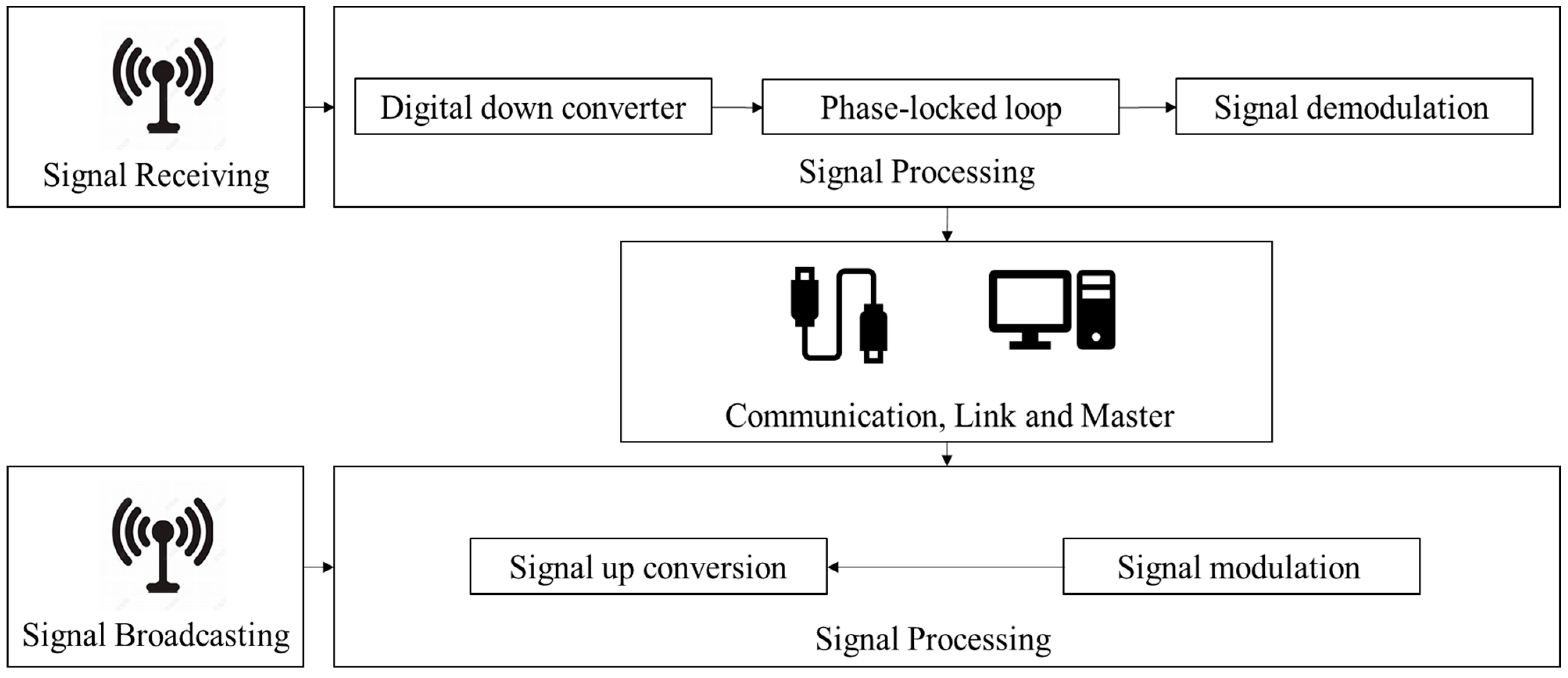
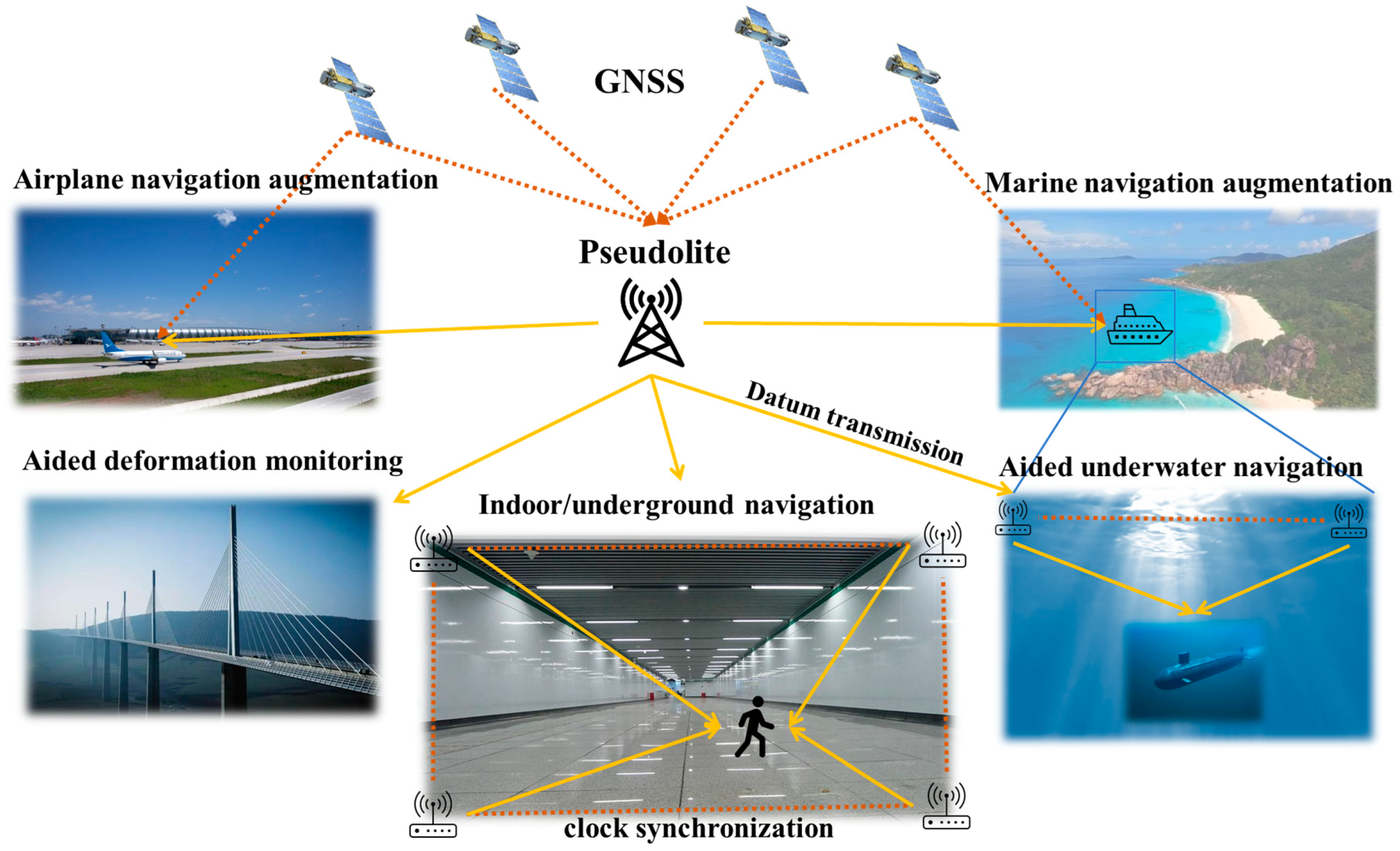

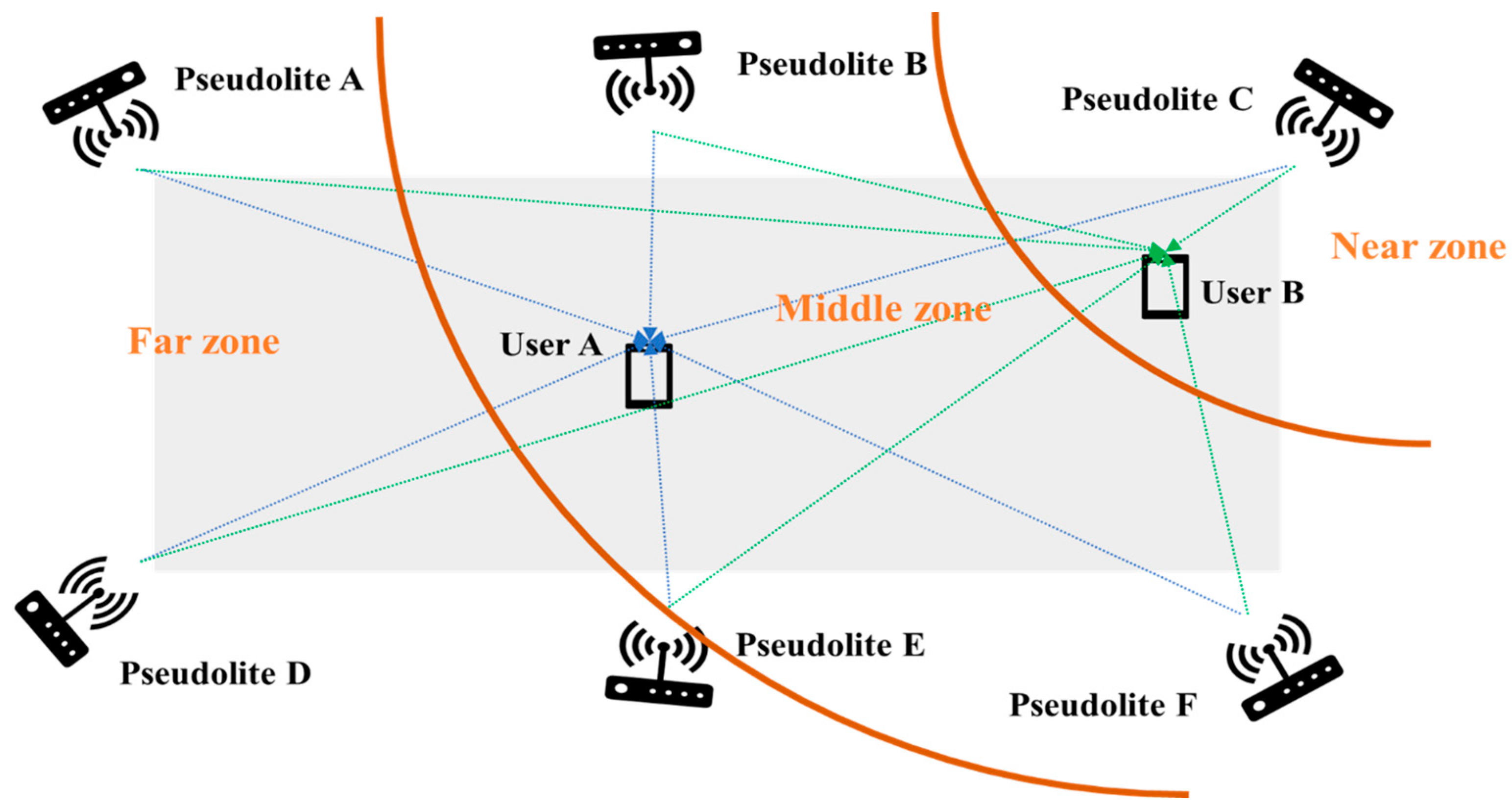
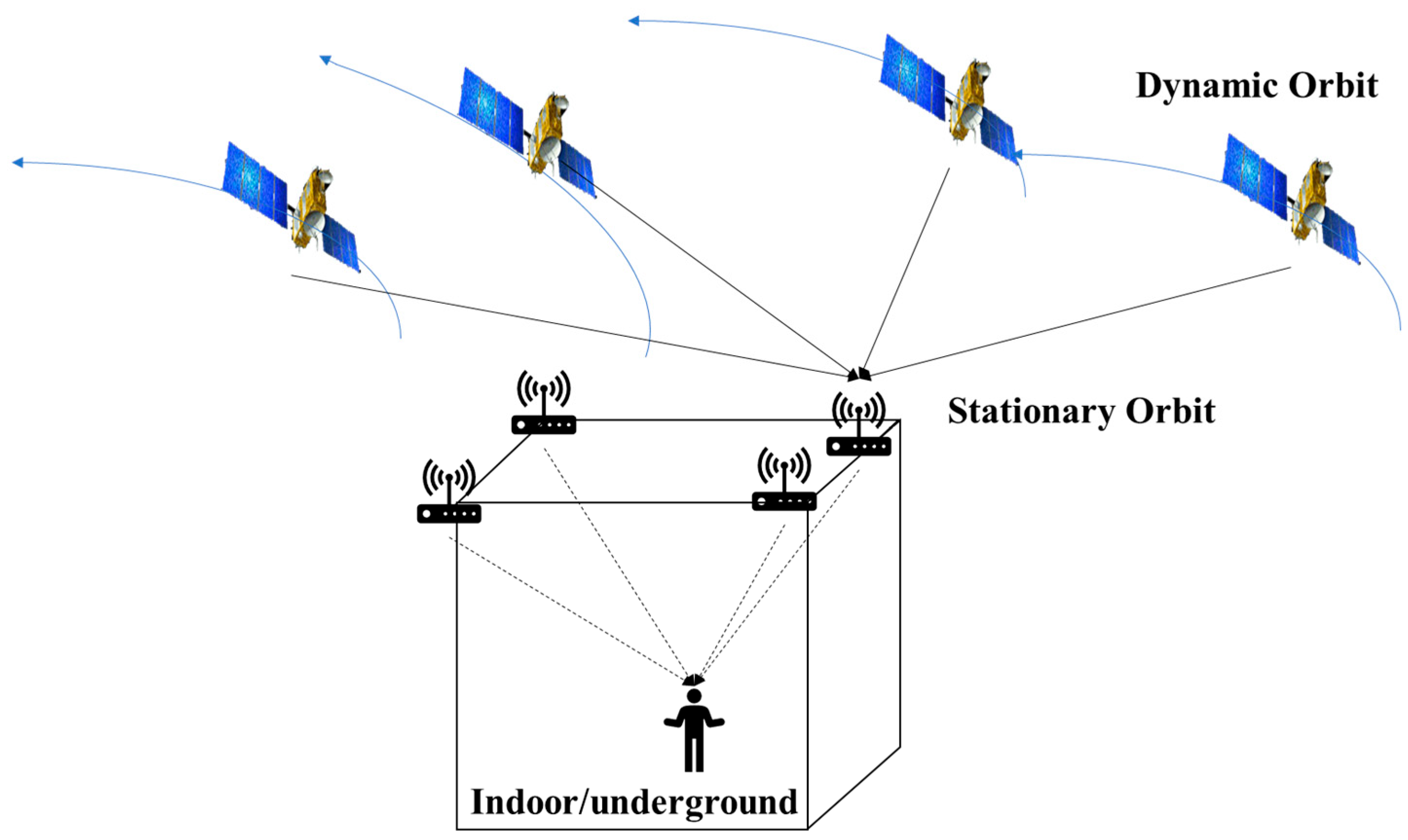
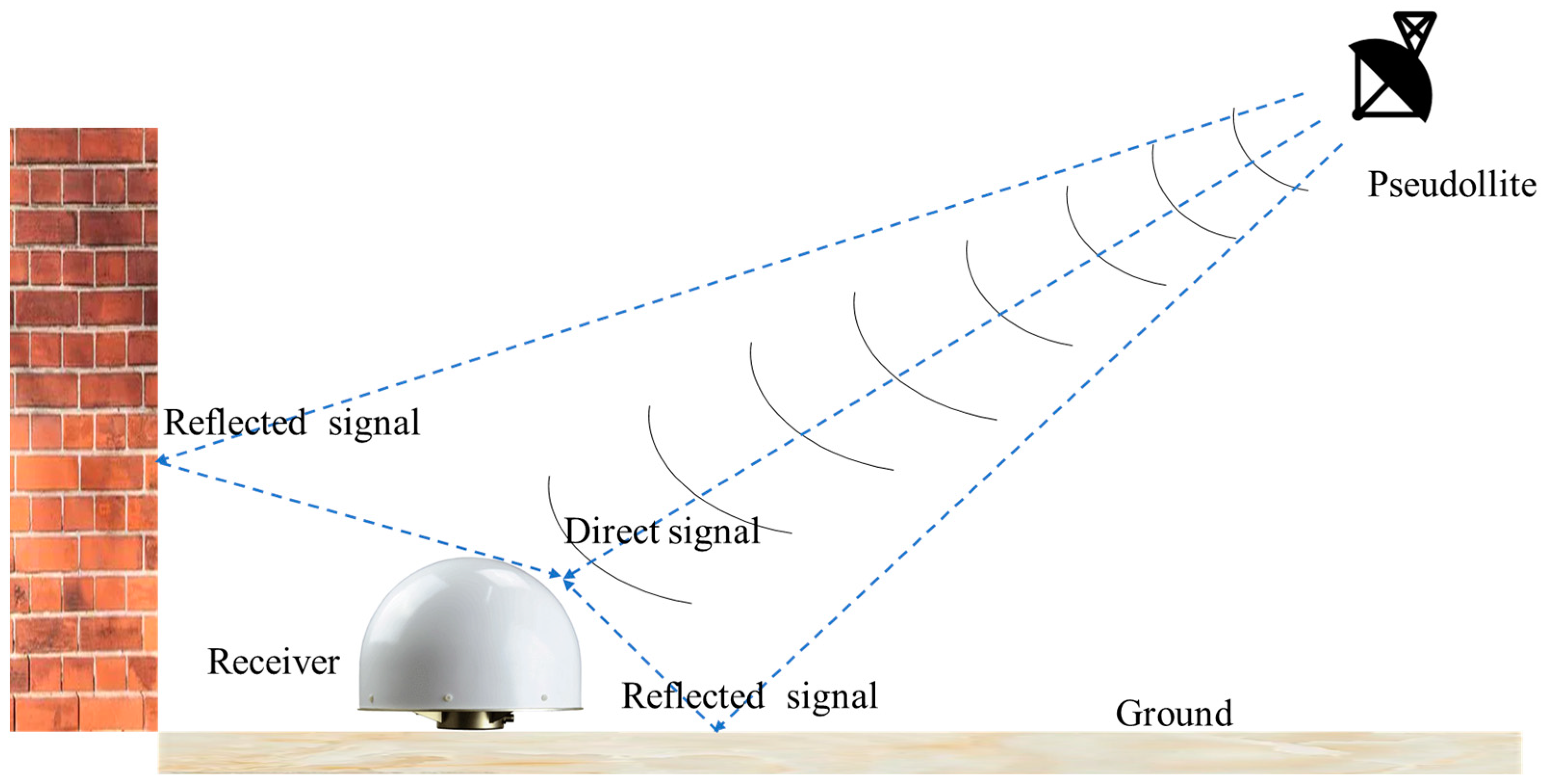
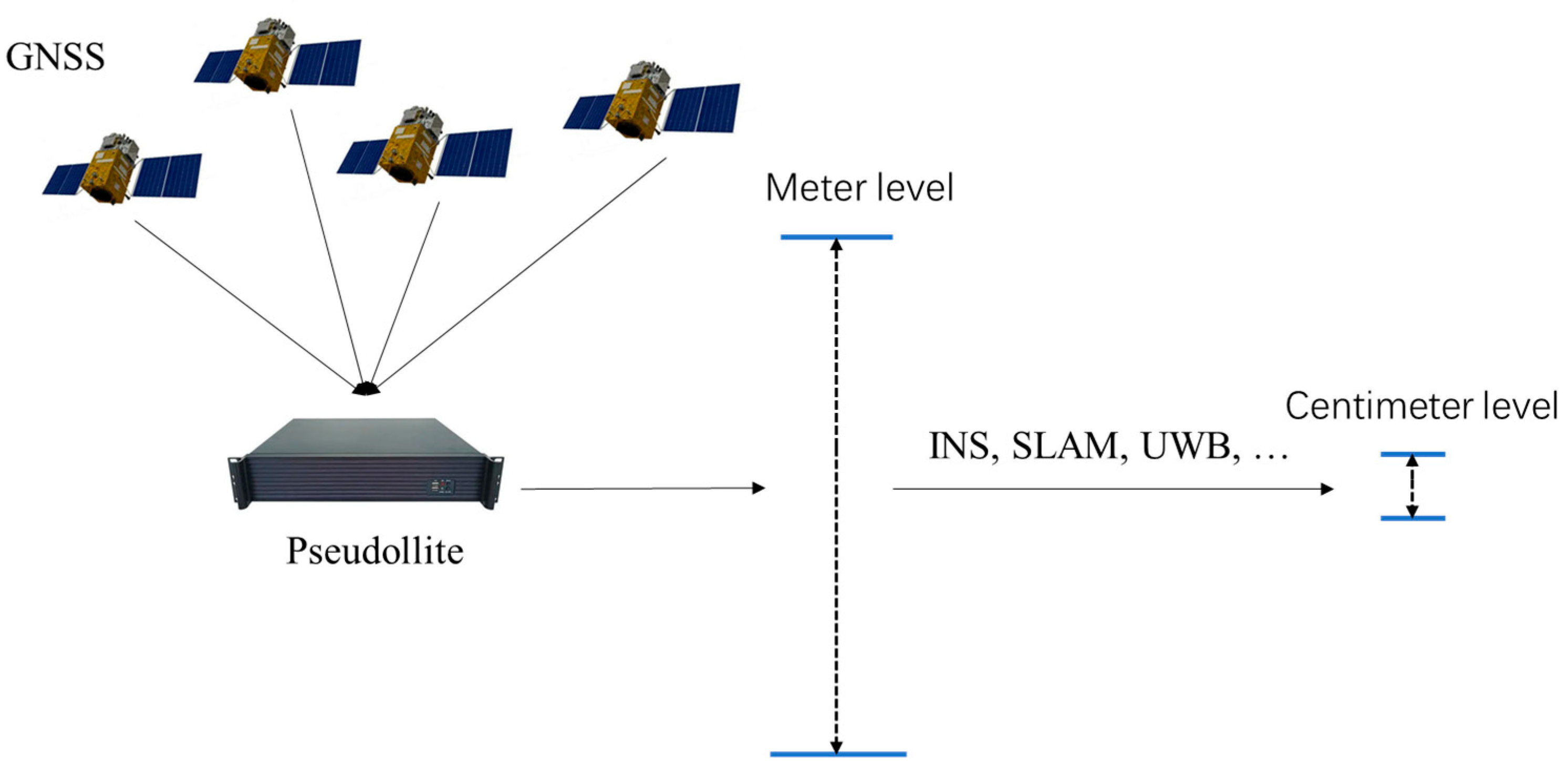
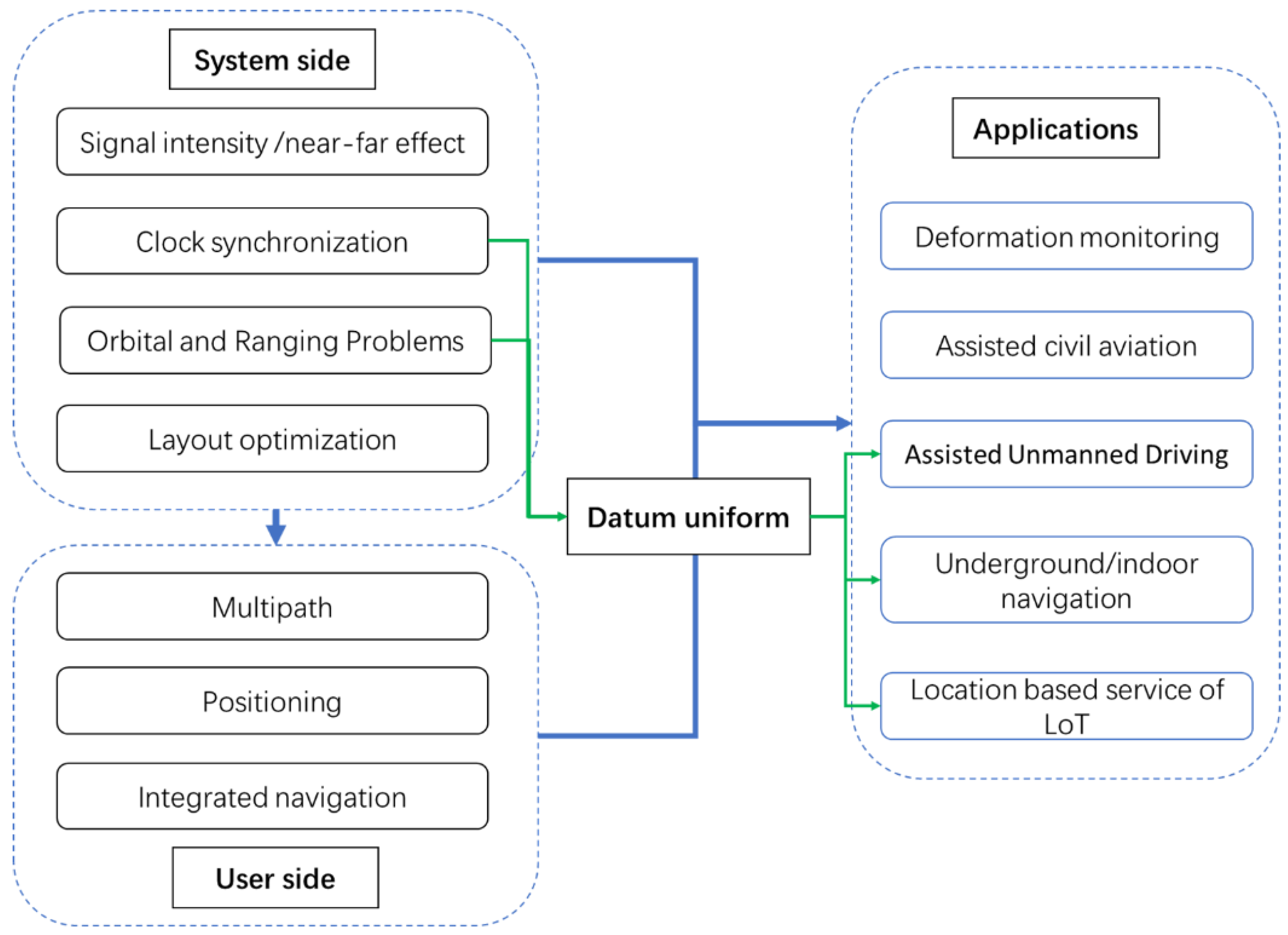
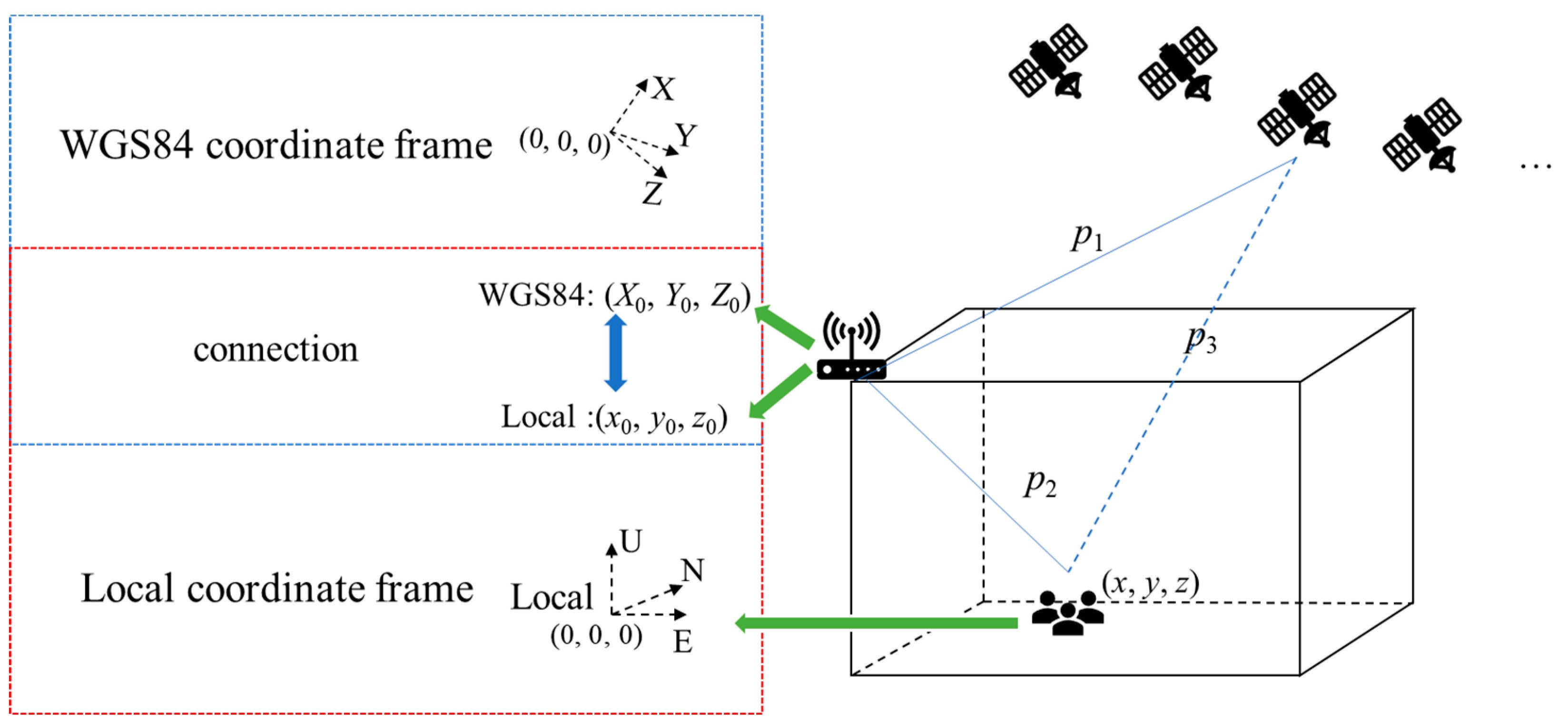
Disclaimer/Publisher’s Note: The statements, opinions and data contained in all publications are solely those of the individual author(s) and contributor(s) and not of MDPI and/or the editor(s). MDPI and/or the editor(s) disclaim responsibility for any injury to people or property resulting from any ideas, methods, instructions or products referred to in the content. |
© 2023 by the authors. Licensee MDPI, Basel, Switzerland. This article is an open access article distributed under the terms and conditions of the Creative Commons Attribution (CC BY) license (https://creativecommons.org/licenses/by/4.0/).
Share and Cite
Liu, T.; Liu, J.; Wang, J.; Zhang, H.; Zhang, B.; Ma, Y.; Sun, M.; Lv, Z.; Xu, G. Pseudolites to Support Location Services in Smart Cities: Review and Prospects. Smart Cities 2023, 6, 2081-2105. https://doi.org/10.3390/smartcities6040096
Liu T, Liu J, Wang J, Zhang H, Zhang B, Ma Y, Sun M, Lv Z, Xu G. Pseudolites to Support Location Services in Smart Cities: Review and Prospects. Smart Cities. 2023; 6(4):2081-2105. https://doi.org/10.3390/smartcities6040096
Chicago/Turabian StyleLiu, Tong, Jian Liu, Jing Wang, Heng Zhang, Bing Zhang, Yongchao Ma, Mengfei Sun, Zhiping Lv, and Guochang Xu. 2023. "Pseudolites to Support Location Services in Smart Cities: Review and Prospects" Smart Cities 6, no. 4: 2081-2105. https://doi.org/10.3390/smartcities6040096
APA StyleLiu, T., Liu, J., Wang, J., Zhang, H., Zhang, B., Ma, Y., Sun, M., Lv, Z., & Xu, G. (2023). Pseudolites to Support Location Services in Smart Cities: Review and Prospects. Smart Cities, 6(4), 2081-2105. https://doi.org/10.3390/smartcities6040096




